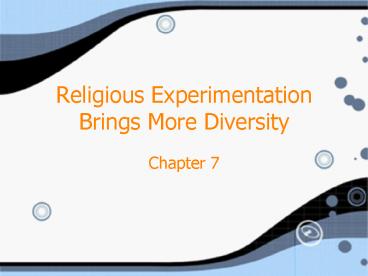Religious Experimentation Brings More Diversity - PowerPoint PPT Presentation
1 / 10
Title:
Religious Experimentation Brings More Diversity
Description:
... led by Ellen G. White being a primary example; White promoted the idea that Christ did not return because his followers were not prepared, ... – PowerPoint PPT presentation
Number of Views:15
Avg rating:3.0/5.0
Title: Religious Experimentation Brings More Diversity
1
Religious Experimentation Brings More Diversity
- Chapter 7
2
I. Revisiting the Bible Restoration
- During the early years of the 19th century, a
primary impetus among new religious movements was
a re-imagining, or really a return, to the
original sense and meaning of the Bible - Such a move endowed power (95) to the members
of new movements, since their claim was that
they, not everyone else, was recapturing the
truth of apostolic times - Restorationism (see p. 92) was a prime example
of such an impulse, its two primary strains
arising out of the same origin, the
Stone-Campbell Movement
3
I. Revisiting the Bible Restoration
- Barton Stone and Alexander Campbell both thought
denominations were based on arbitrary divisions,
and all Christians would be united if they read
and understood the Bible through simple common
sense - They wished to return to a simple, biblical,
apostolic Christianity (92) - Both, however, were perceived as founders (or
figureheads at least) of two separate
denominations the Churches of Christ (Stone) and
the Disciples of Christ (Campbell)
4
II. Revisiting the Bible Innovation
- Like Stone and Campbell, Joseph Smith wished to
return Christianity to its original, apostolic
origins unlike the former two, he did so by
introducing a new set of canonical writings and a
new mythological history set entirely in America - Central to Smiths Church of Latter-day Saints
was the idea that Israels history continued in
the New World and kept on continuing by the
stream of new revelation that was ongoing from God
5
II. Revisiting the Bible Innovation
- Having opened the canon to new truth, Smith took
on the mantle of prophet, a move for which he
would be persecuted, ending ultimately in his
martyrdom in Illinois - However, the movement continued, most prominently
under the leadership of Brigham Young who
migrated with the majority of Smiths followers
to Utah, where they continued to experience great
growth in the midst of oppression
6
III. Utopia in America
- The early 19th century also bore witness to an
explosion of communitarian communities, both
religiously (primarily Christian) and
economically-based - Though most were short-lived, they did succeed
for a time in bringing heaven to earth, given
that the goal of many of these communities was to
live as things would be during the millennium of
Christs return
7
III. Utopia in America
- The Oneida community, started by John Humphrey
Noyes, was founded on the idea that Christ had
returned in 70 A.D., that they were living in the
millennium and thus, perfection was possible and
all communal ties dissolved (especially marital
ones) - Complex marriage, where all spouses were held
in common, and stirpiculture, the eugenic process
of creating perfect children, were the beliefs
for which Noyes and the community received the
bulk of its critique (see pp. 96-97) - Brook Farm, the Transcendentalist,
Fourierist-inspired utopian community of George
Ripley, was notable for intellectually-charged
atmosphere - Things dissolved when the economic endeavor
failed, but difficulty arose early from the
inability to balance the import of growth in
Transcendental principles and sustainable work
8
IV. The End is Near Adventism and Millennialism
- Expectation of Christs imminent return, and
speculation as to Americas role in that event,
color the landscape of American religious
history, of which some of the most fervent
examples occurred in the early-mid 19th century - Speculation about history, reading endtimes
into historical events became an endeavor common
to those who saw history as coming to a close - Theological camps tended to divide into two
groups - Pre-millennialists (Adventist) those who
believed that the Rapture was set to occur prior
to Christs 1000 year reign - Post-millennialists (Millennialist) those who
believed that the close of history would occur
following Christs reign
9
IV. The End is Near Adventism and Millennialism
- The Millerites, the Seventh-Day Adventists and
the Jehovahs witnesses are the most prominent
examples of such viewpoints - William Miller, leader of the eponymous
Millerites, through a sophisticated and complex
reading of the Bible, determined that the Christ
would return on October 22, 1844, a date that
would later be known as The Great
Disappointment (p. 99) - Though the Millerite movement fractured, splinter
groups grew out of it with the same
expectational principles- the Seventh-Day
Adventists, led by Ellen G. White being a primary
example White promoted the idea that Christ did
not return because his followers were not
prepared, prompting her to promote reinstitution
of the Seventh-Day sabbath and various health
reforms - The Jehovahs Witnesses, begun by Charles Taze
Russell on the other hand felt that Christ had
returned (in 1874), but in the spiritual realm
only
10
V. Religion and the Mind
- Many, instead of looking outward to history,
turned inward at the human mind itself to
uncover a larger frame of meaning for all of
life - Most saw the connection between the mind and
body whatever was occurring bodily was often a
problem originating in bad thought, thus,
healing the mind became a primary objective of
such movements - Tapping into the mind meant connecting with God,
an Oversoul or transcendent entity - Emanuel Swedenborg, a Swedish religious mystic
would influence many American-grown movements,
such as the Transcendentalists, Phineas Quimby
and his healing ministry and Mary Baker Eddy and
Christian Science (see pp. 102-104 for more)










![NOTE: To appreciate this presentation [and insure that it is not a mess], you need Microsoft fonts: PowerPoint PPT Presentation](https://s3.amazonaws.com/images.powershow.com/6387942.th0.jpg?_=20200719041)




















